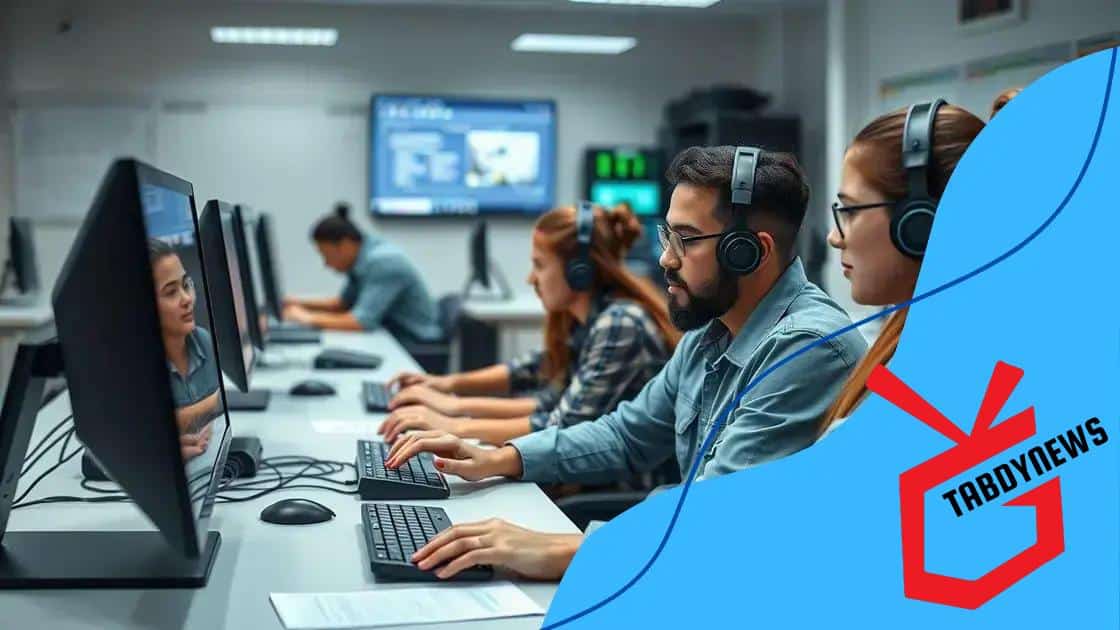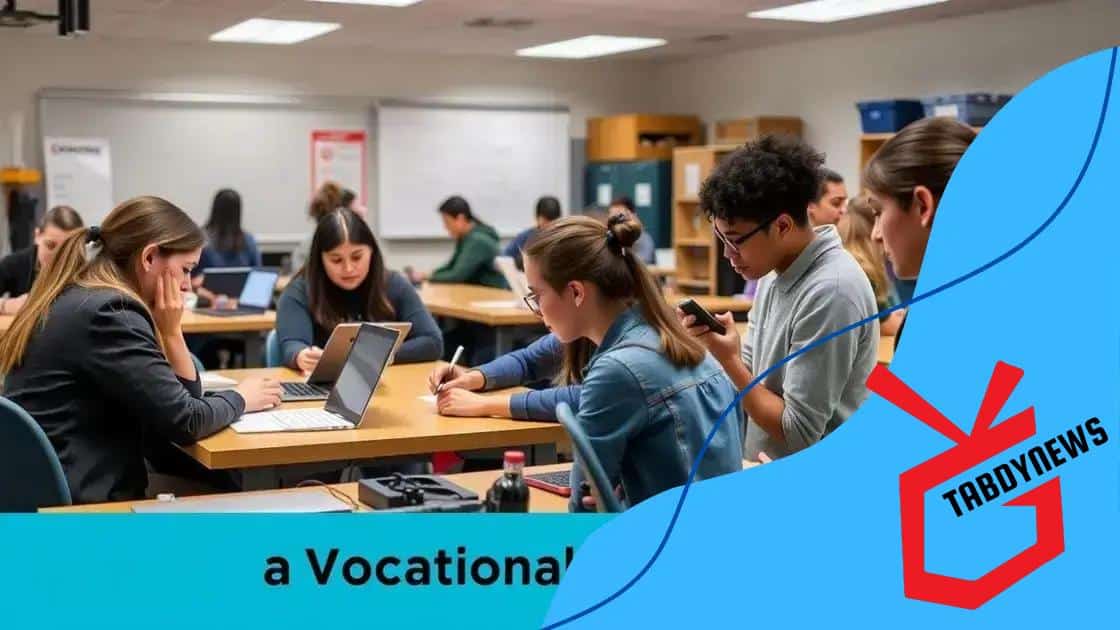Vocational education adapting to AI trends for success

Vocational education is evolving with AI integration, emphasizing personalized learning, practical skills, and collaboration with industries to prepare students for the modern workforce.
Vocational education adapting to AI trends is becoming crucial in preparing students for the job market. Have you wondered how these changes might shape your career prospects? Let’s explore the exciting developments!
Understanding AI’s impact on vocational education
In today’s world, artificial intelligence (AI) is revolutionizing many fields, including vocational education. Understanding AI’s impact on vocational education helps students gain skills aligned with modern job demands.
AI tools allow for personalized learning experiences. This means that students can learn at their own pace and focus on what they need. Adaptive learning technologies assess a student’s strengths and weaknesses, tailoring content to fit individual needs.
Benefits of AI in vocational education
By integrating AI, vocational programs can enhance the learning experience significantly. Some benefits include:
- Increased engagement through interactive simulations.
- Improved assessment methods that provide instant feedback.
- Access to a wider range of resources, including online tutorials and industry-standard software.
Moreover, employing AI fosters collaboration among students. Virtual classrooms and AI-driven platforms support peer interactions and enhance teamwork skills, essential in many careers.
Examples of AI in action
Across various institutions, examples of AI implementations showcase its positive influence. For instance, some programs use chatbots to answer student queries instantly. This enhances support services and helps students feel connected.
Furthermore, immersive technologies like virtual reality can replicate real-world scenarios. Students can practice skills in a safe environment, building confidence before entering the workforce.
As we move forward, it’s clear that understanding AI’s transformative role in vocational education is crucial. The blend of technology and education prepares students better for their future careers, ensuring they have the skills required in a rapidly changing job market.
Key skills needed in the AI era
The AI era demands new skills for success in the workforce. As technology evolves, so must our capabilities. Understanding the key skills needed in this evolving landscape is critical for vocational education.
One essential skill is data literacy. In today’s workplaces, the ability to analyze and interpret data allows professionals to make informed decisions. This skill is applicable across various fields, ensuring that students are prepared for diverse career paths.
Collaboration and communication
Effective collaboration and communication are also vital. As teams become more diverse and remote, being able to work well with others is crucial. Graduates need to excel in sharing ideas and providing constructive feedback.
- Engaging in team-based projects.
- Practicing active listening skills.
- Learning conflict resolution techniques.
Additionally, critical thinking is a must. Analyzing situations and solving problems creatively will position students to tackle challenges in the workplace effectively. It allows for innovative solutions in a fast-paced environment where quick adaptability is necessary.
Technical proficiency
Moreover, technical proficiency is incredibly important. Familiarity with emerging technologies and tools enhances employability. Vocational programs should provide training on various software and platforms that are prevalent in today’s industries.
This hands-on experience will prepare students to adapt quickly to changes. As they learn these technologies, they will also develop problem-solving and critical thinking skills, further enhancing their employment prospects.
Emphasizing these key skills in vocational education will ensure students are ready to meet the challenges posed by the AI era. A robust educational foundation that focuses on essential attributes like collaboration, data literacy, and technical abilities prepares graduates for future success.
How vocational training programs are evolving

Vocational training programs are constantly evolving to keep pace with technological advancements and the changing job market. As industries adopt new technologies, these programs are adapting to provide relevant skills and knowledge to students.
One significant change is the integration of online learning platforms. These platforms allow students to access materials and workshops remotely, providing flexibility in their education. Now, students can learn at their own pace, making vocational training more accessible than ever before.
Hands-on learning opportunities
Additionally, vocational programs are emphasizing hands-on learning. By partnering with local businesses, schools provide students with real-world experiences. This approach allows learners to apply their skills in actual work settings.
- Internships give students practical experience.
- Workshops offer simulated training environments.
- Guest speakers share insights from the industry.
This experiential learning fosters confidence and prepares students for the workforce. Moreover, mentorship programs connect learners with industry professionals, providing guidance and support as they navigate their career paths.
Emphasis on soft skills
Beyond technical skills, there is a growing focus on soft skills in vocational training. Skills such as communication, teamwork, and problem-solving are becoming just as critical as technical abilities. Programs now teach these essential traits alongside traditional curriculum.
By incorporating these skills, training programs help students become well-rounded individuals. This holistic approach ensures they are not only job-ready but also capable of growing within their careers.
As we examine how vocational training programs are evolving, it’s clear that they are embracing technology, hands-on experiences, and a focus on soft skills. These shifts ensure that graduates are well-prepared for the demands of the modern workforce.
Real-world examples of AI in vocational education
In recent years, the integration of artificial intelligence in vocational education has transformed how students learn and interact with technology. Real-world examples showcase the benefits and versatility of AI in various training programs.
One notable application is the use of AI-driven tutors. These intelligent systems provide personalized learning experiences by adapting lessons based on a student’s pace and understanding. This targeted approach helps learners grasp difficult concepts more effectively.
Case studies in vocational training
For instance, a community college in California implemented an AI tutoring system for its welding program. Students receive immediate feedback on their techniques, allowing them to improve faster than with traditional methods.
- Students work with VR simulations to practice their welding skills.
- Individual learning paths are created using data analytics.
- Real-time performance measurements guide students in honing their craft.
Another example can be found in culinary schools using AI enhanced tools. Here, students learn about cooking techniques through interactive AI applications that analyze their cooking processes in real time. This hands-on learning helps understand complex culinary skills better.
AI in assessment methods
AI also revolutionizes assessment methods in vocational education. Traditional tests are being replaced by dynamic, AI-powered evaluations that measure skills and knowledge more accurately. For example, an automotive training program uses AI to evaluate students’ practical skills through real-time assessments during hands-on activities.
This allows instructors to provide instant feedback and identify areas needing improvement. As students work on vehicles, AI analyzes their techniques and provides insights into their performance. This immediate feedback loop enhances learning outcomes.
These real-world examples illustrate how integrating AI in vocational education significantly enhances the learning experience, providing personalized support and modernizing assessment methods. As educators embrace this technology, students are better prepared for their future careers.
Future trends in vocational education and AI
The future of vocational education is closely linked to advancements in artificial intelligence. As we move forward, several trends are expected to shape how students learn and develop skills.
One primary trend is the rise of adaptive learning technologies. These technologies adjust the educational experience based on individual student needs. By assessing a learner’s progress, adaptive systems provide customized resources and support, allowing for a more personalized educational journey.
Integration of AI tools
Additionally, the integration of AI tools into vocational training will continue to grow. This includes the use of chatbots for student support and AI-driven assessments for skill evaluations. These tools can provide students with immediate feedback, helping them identify areas where they need improvement.
- Chatbots answer common questions 24/7.
- AI assessments track progress and suggest personalized pathways.
- Virtual mentors provide guidance throughout the learning process.
Moreover, the demand for remote learning options will expand. More vocational programs will offer online classes and virtual workshops, making education more accessible. This approach allows students to gain valuable skills from anywhere in the world, breaking down geographical barriers.
Focus on soft skills and emotional intelligence
Furthermore, there will be a greater emphasis on teaching soft skills alongside technical abilities. As workplaces evolve, skills such as communication, teamwork, and emotional intelligence are becoming increasingly important. Programs will need to integrate these aspects into their curricula to prepare students effectively.
As technology continues to advance, collaborations between industries and educational institutions are essential. These partnerships can ensure that vocational training aligns with current market demands. By working together, schools can develop programs that prepare students for the skills needed in the workforce.
The trends in vocational education and AI point toward a more integrated and personalized approach to learning. These changes promise to create a more skilled workforce ready to meet the challenges of the future.
FAQ – Frequently Asked Questions about AI in Vocational Education
How is AI changing vocational training?
AI is personalizing learning experiences, providing immediate feedback, and allowing for adaptive learning paths tailored to individual students.
What skills will be emphasized in future vocational programs?
Future programs will focus on both technical skills and soft skills, such as communication and teamwork, to prepare students for the modern workforce.
Can AI tools help with assessment in vocational education?
Yes, AI tools can streamline assessments, offering real-time evaluations and feedback to help students improve quickly.
What is the role of industry partnerships in vocational education?
Industry partnerships help ensure that vocational training programs remain relevant by aligning curriculum with current job market needs.





